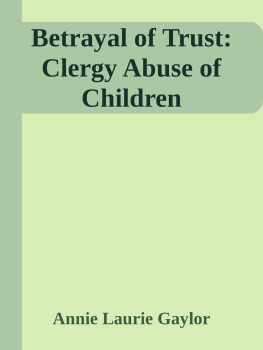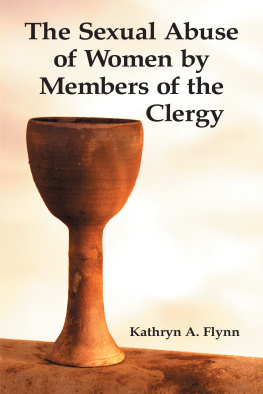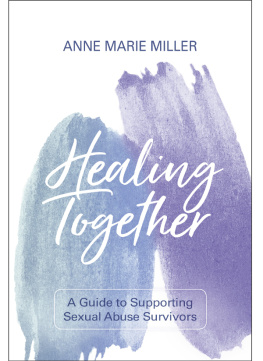
Scripture quotations, unless otherwise noted, are from the New Revised Standard Version of the Bible, copyright 1989, Division of Christian Education of the National Council of the Churches of Christ in the United States of America and are used by permission.
Copyright 2004 by the Alban Institute. All rights reserved.
This material may not be photocopied or reproduced in any way without permission from the publisher. Go to http://www.alban.org/permissions.asp
Cover design: Adele Robey, Phoenix Design
Library of Congress Cataloging-in-Publication Data
McClintock, Karen A., 1953
Preventing sexual abuse in congregations: a resource for leaders / Karen A. McClintock.
p. cm.
Includes bibliographical references.
ISBN 1-56699-295-8
1. Pastoral theology. 2. Sex crimes--Prevention. 3. Sexual harassment--Prevention. I. Title.
BV4011.3.M33 2004
261.8'3272--dc22
2004010342
11 12 13 14 15 VG 4 5 6 7
Dedication
Written in gratitude for the life and faith of
Alene Dorcas Felder
19182003
FOREWORD
T hose of us who work at picking up the pieces in shattered congregations have also spilled quite a bit of ink writing about recovery in the aftermath of clergy trust betrayals. However, we have not had a good resource that aims squarely at prevention in the congregation. And so it is with great pleasure that I write the foreword to this very timely and much-needed resource.
Because Karen McClintock writes out of the depth of her own considerable experience, she is able to deliver wise advice about all the obstacles that hinder the congregation's ability to engage in healthy relationships while also being in community. Strategies for shame reduction, releasing the stranglehold of secrets, discerning what constitutes respectful and nurturing touch, coping with addictive behaviors, and creating safety in counseling settings are all here, and McClintock's approach avoids the extremes of either establishing rigid rules or just muddling through.
I would go so far as to say that we risk being seriously negligent if we do not fully embrace the task of preventing sexual abuse in our faith communities. Furthermore, we can provide a model for the rest of the culture, which at this time seems hopelessly entangled in a toxic mix of sexual repression and obsession. This lively, frank, and compelling book will make the task much easier.
Both the content and the design of this book offer very accessible descriptions of all the common dilemmas, occasions for personal reflection, suggestions for group work, and good examples of policies and procedures. The dynamic of gradual creep is also fully described and explained, and clergy, seminarians, congregants, and judicatory officials who read this book may be much more likely to heed any warning flags well ahead of the storm. Each chapter addresses a topic that leaders and congregants can examine in depth.
Prevention of sexual abuse requires that certain steps be taken, and there is a logical order in which they generally need to occur. The first step is often overcoming the massive inertia and shame that most of us carry aroundregarding not only issues of sexuality, but also issues of abuse of power. The two are so intertwined as to be hard to tease apart, and one often masks the other. If we remind ourselves that doing nothing is also making a decision, it may be easier to take that most difficult first step, even if we know that it is inevitable that some people in the congregation will try to block the initiative before it is even more than a gleam in someone's eye.
Although we can reasonably anticipate significant resistance to this discussion, I see another use for this book: it can serve as a major tool of recovery for congregations that have incidences of serious leadership abuse anywhere in their pasts, even when the abuse has not been overtly sexual in nature. We have learned that overt sexual abuse in a congregation is usually just the tip of the abuse iceberg. Intimidation, harassment, emotional abuse, a rigid and arbitrary leadership style, withdrawal into gradual isolation, all seem to be highly damaging fellow travelers in such settings.
When abuse happens in the context of a faith community, it often develops gradually, so that people lose their ability to see and name what is going on. Perpetrators are often adept at sending very mixed signals, and paradoxically, the offender often is charismatic and one on whom people easily become dependent. Confusion becomes the order of the day, and the silence and repression required to keep the blinders on can gradually creep into the entire system. Often, laity in these settings believe they, too, have permission to be abusive. Then a congregation may be set up to experience a string of multiple abuses of power from lay or clerical leaders well after the original, perhaps even forgotten, traumatic event. The resulting culture of abuse sets the community up for a massive crisis when an offender is finally removed. Therefore, any time we gain entry into a recently traumatized congregation, not only is serious recovery work indicated, but preventive work must surely follow.
As with the task of abuse prevention, however, recovery entails a developmental process. First, people need to be given information, education, and then plenty of time to grieve their losses, however these are experienced. Then they must begin the arduous process of reestablishing trust at all levels of the congregation. This takes far more time and effort than many are willing to give, but it cannot be rushed, and time spent on the front end will yield great dividends later on. Once these tasks are accomplished, a gradual readiness to take the longer and deeper look at the quality of communal life will emerge. I believe every congregation in recovery would benefit from a careful study of all the issues that surround sexuality, using this book as the text to guide that study.
This book is an invaluable tool, therefore, not only for those who want to apply it purely as a prevention measure, but also for those who want to put the crowning touch to a well-designed recovery process after any kind of serious power abuse has taken place. In fact, there is a short period in a congregation's development following a major crisis when the attention of congregants is riveted on the recent traumatic events. In spite of the current upheaval, leaders are often presented with a perfect opportunity to bring about major and lasting change in a system that may have slowly closed in on itself, with disastrous results. The opportunity should not be squandered.
Even as we undertake this often difficult journey, we need to be gentle with ourselves and others as we explore together the deep scars that many of us carry. Because dealing with issues of sexuality takes a lot of psychic energy, I would advise going slowly and giving people enough time to absorb the information and its effect on them in a context of care and support. A retreat setting with opportunities to take walks, talk informally, and laugh at the absurdity of it all would help.
As a people set in a certain time and culture, we all carry some of the scars collectively. The twin journeys of prevention and recovery are well worth going on together.
Nancy Myer Hopkins
PREFACE
A re you ready to abuse-proof your congregation? If one child or adult is spared the confusing ordeal of enduring unwanted touch, it will be worth your time to read this book. If you, having read this book, notice some impropriety and speak up about it right away, you may stop a child or adult parishioner from victimization. You may be able to prevent a pastoral marriage from ending. You may avoid a congregational scandal that leads to a decline in the vitality and membership of your congregation. Whether you are a pastor, a lay person, or a student preparing for ministry, you can be more aware of the dangers that are inherent in pastoral ministry and alert to the risks of sexual boundary crossings.
Next page






